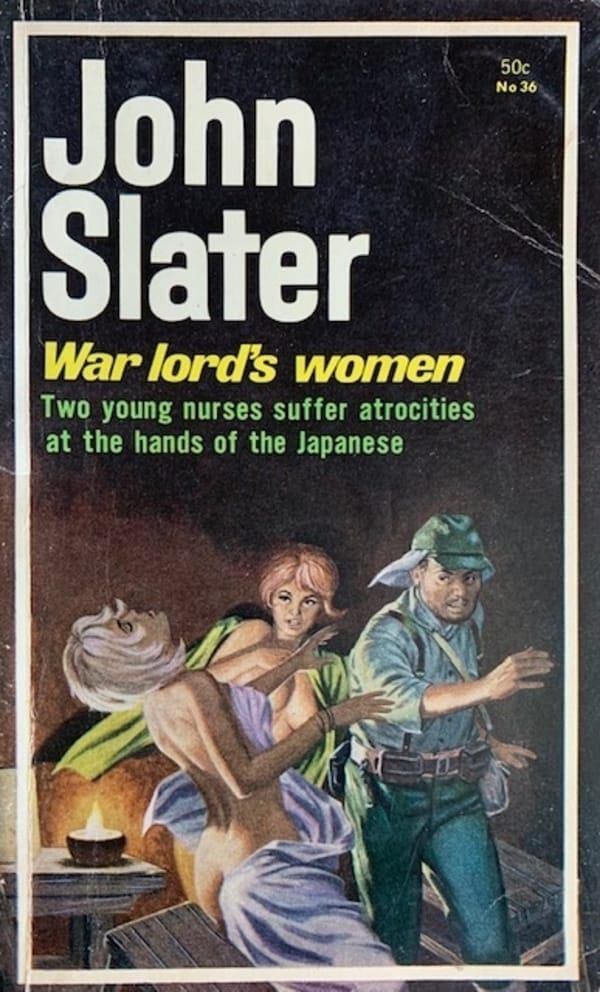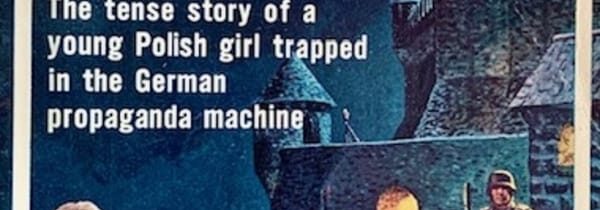TRASHY TUESDAY: AUSTRALIAN NAZI EXPLOITATION PULP – SWASTIKA CASTLE by John Slater (Horwitz, 1966)

The John Slater series (Horwitz Publications) of exploitation novels ran from 1962 to 1973. Most of them were actually written by the prolific Ray Slattery and nearly all of them featured prisoners (usually women) being tortured by sadistic Nazi or Japanese guards during the war. Some, however, explored other forms of slavery and exploitation, such as the 1972 Bikie Slave.
The John Slater books were matched by other Australian series, such as the Jim Kent novels, that also featured “sadism and brutality” at the hands of the Japanese and Nazi torturers. The books almost invariably boasted provocative covers of near naked women and leering guards, which undoubtedly helped to boost sales, although the contents were very bland in comparison to the covers. Taken together, this fascination with torture and imprisonment represents a strange digression in Australian pulp war fiction in the 1960’s.
I recently came across a copy of Swastika Castle, which sticks pretty close to the Slater formula. The story is a bit of a mess, but it features a Polish girl, Karen Wenski, who is taken by the Nazis to a remote castle where she is subjected to brain washing techniques, which owe more to 1960 spy films than they do to the reality of Nazi Germany. She is part of a program to prepare “young women of defeated enemy States to spread pro-German sentiments, and so do something toward easing our occupation… By projecting an image of the lovely, happy young woman, we will do more to sell Nazism to her country than all the speeches of our great leaders.” Fortunately a former suitor learns of Karen’s fate and sets out to save her.
Despite being naked for a lot of the book, the tortures inflicted on Karen are very mild compared to the reality of German concentration camps and the contents of the book are quite tame. The book ends on a typical Slater note with Karen and her rescuer driving hand-in-hand to a safe house.
As with most of the Slater books, Swastika Castle, benefits greatly from an eye-catching cover by the prolific Australian maestro of cheesy covers, Col Cameron. As is usually the case, the cover bears little resemblance to the contents of the book. Karen is never chased bare footed and scantily dressed over rocks pursued by whip carrying guards and vicious dogs, but it does make for a great cover.
Cameron makes good use of the forbidding dark, Dracula-like castle in the background and the snarling dog in the foreground to generate a good sense of terror. The light from the guard’s torch is cleverly used to draw attention to the subject of the chase, an under-dressed girl with a strategically placed fore-arm to avoid unwanted scrutiny from the censors. The terror created by the guards and the dog, however, is undercut by the weird almost provocative smile on the girl’s face. Cameron was not the most gifted drawers of figures, but the drawing of Karen seems particularly clumsy with the strangely positioned left arm and the elongated right forearm. As with most of the drawings by Cameron, the girl has an unlikely blonde bob, which is almost a signature feature of his drawings (see below).
In all, not a great book or cover, but a good example of the ‘prisoner romance’ fascination which gripped Australian paperback publishers in the 1960’s and early 70’s.
Some more ‘Cameron bobs’:




The things we read …. (or have read). Would they be published today, do you think?
No they wouldn’t be published today. Very poorly written. They are interesting though, I wonder whether the Japanese ones were somehow compensating for Australia’s experience of war and the large number of Australian soldiers who were captured by the Japanese early on in the war?
Interesting, just picked up a few of these books (Slater, Kent) in a junk shop here in NZ!
That is lucky – they are hard to find these days. I found most of mine in this old barn like bookshop in a country town!